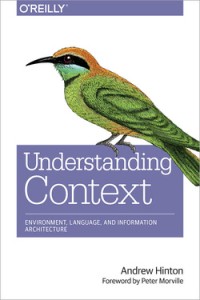Understanding Context by Andrew Hinton.
From the post:
Technology is destabilizing the way we understand our surroundings. From social identity to ubiquitous mobility, digital information keeps changing what here means, how to get there, and even who we are. Why does software so easily confound our perception and scramble meaning? And how can we make all this complexity still make sense to our users?
Understanding Context — written by Andrew Hinton of The Understanding Group — offers a powerful toolset for grasping and solving the challenges of contextual ambiguity. By starting with the foundation of how people perceive the world around them, it shows how users touch, navigate, and comprehend environments made of language and pixels, and how we can make those places better.
Understanding Context is ideal for information architects, user experience professionals, and designers of digital products and services of any scope. If what you create connects one context to another, you need this book.
Amazon summarizes in part:
You’ll discover not only how to design for a given context, but also how design participates in making context.
- Learn how people perceive context when touching and navigating digital environments
- See how labels, relationships, and rules work as building blocks for context
- Find out how to make better sense of cross-channel, multi-device products or services
- Discover how language creates infrastructure in organizations, software, and the Internet of Things
- Learn models for figuring out the contextual angles of any user experience
This book is definitely going on my birthday wish list at Amazon. (There done!)
Looking forward to a slow read and in the meantime, will start looking for items from the bibliography.
My question, of course, is that after expending all the effort to discover and/or design a context, how do I pass that context onto another?
To someone coming from a slightly different context? (Assuming always that the designer is “in” a context.)
From a topic map perspective, what subjects do I need to represent to capture a visual context? Even more difficult, what properties of those subjects do I need to capture to enable their discovery by others? Or to facilitate mapping those subjects to another context/domain?
Definitely a volume I would assign as reading for a course on topic maps.
I first saw this in a tweet by subjectcentric.
